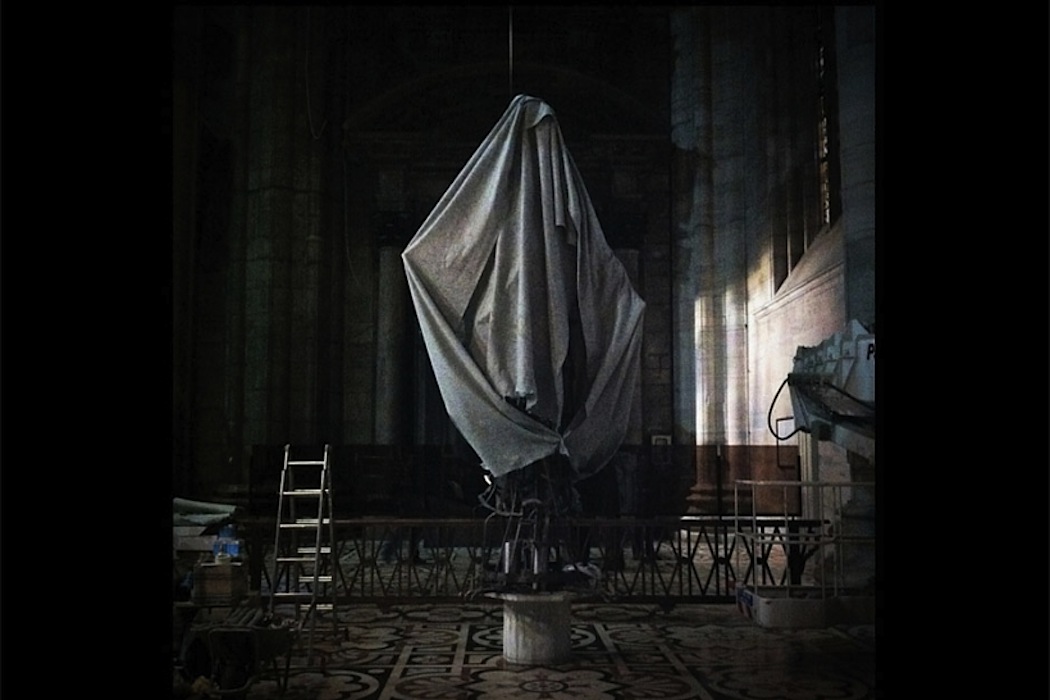
Još ove dvije godišnje liste i to je to.
boomkat.com/collections/boomkat-charts-2013








































































5:4
5against4.com/2013/12/30/best-albums-of-2013-part-1/
Continuing my round-up of the best music of the year, here’s the first part of the most outstanding albums of 2013; part two will be coming tomorrow.
40 | Blue Hawaii –
 Proving
once again that much of the most imaginative poptronica comes from
Canada, Blue Hawaii’s first full-length LP shows them to have attained a
point of real maturity. Adopting a different approach from her other
group Braids, singer Raphaelle Standell-Preston subjects her voice to
far more experimental treatment here, enfolding it in on top of itself,
slicing it up & dispersing it around the rock-solid layers of
electronic firmament laid down by Alex Cowan. There’s dreaminess aplenty
to be found in the mix, but the music here is working towards
altogether more forthright ends.
Proving
once again that much of the most imaginative poptronica comes from
Canada, Blue Hawaii’s first full-length LP shows them to have attained a
point of real maturity. Adopting a different approach from her other
group Braids, singer Raphaelle Standell-Preston subjects her voice to
far more experimental treatment here, enfolding it in on top of itself,
slicing it up & dispersing it around the rock-solid layers of
electronic firmament laid down by Alex Cowan. There’s dreaminess aplenty
to be found in the mix, but the music here is working towards
altogether more forthright ends.[Arbutus | iTunes]
39 | Andrew Liles – INCOMMENSURABLE MAGNITUDES
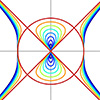 One’s
gut reaction, confronted with one of the longest albums ever
recorded—exactly 24 hours’ duration—is to consider the herculean
compositional effort it must have taken for Andrew Liles to create such a
behemoth. But one of the most remarkable things about it—as with all
Liles’ work—is how completely effortless & spontaneous it sounds. As
one might expect for such an epic duration, the music takes its time,
& events unfold at a pace that sometimes borders on the techtonic,
yet this is entirely in keeping with the kind of musical encounter Liles
is presenting. It goes way beyond mere immersion, turning the act of
listening into a major event (which, as it turns out, is the only
herculean part of the experience).
One’s
gut reaction, confronted with one of the longest albums ever
recorded—exactly 24 hours’ duration—is to consider the herculean
compositional effort it must have taken for Andrew Liles to create such a
behemoth. But one of the most remarkable things about it—as with all
Liles’ work—is how completely effortless & spontaneous it sounds. As
one might expect for such an epic duration, the music takes its time,
& events unfold at a pace that sometimes borders on the techtonic,
yet this is entirely in keeping with the kind of musical encounter Liles
is presenting. It goes way beyond mere immersion, turning the act of
listening into a major event (which, as it turns out, is the only
herculean part of the experience).[Andrew Liles]
38 | Chubby Wolf – The Last Voices
 One
of the most beguilingly anonymous creations by the late Danielle
Baquet-Long—it remains unclear whether it was even finished before her
death—The Last Voices further demonstrates the subtlety of
creative thinking that makes each Chubby Wolf such a deeply impressive
artefact. Of course, music of such quality renews the call to mourn her
desperately early passing, but we are at least fortunate that
Baquet-Long’s talent was matched by her fecundity. This 3-hour release
brings together what may or may not be three alternate approaches to her
source materials, but regardless it presents some of her most beautiful
& hypnotic work.
One
of the most beguilingly anonymous creations by the late Danielle
Baquet-Long—it remains unclear whether it was even finished before her
death—The Last Voices further demonstrates the subtlety of
creative thinking that makes each Chubby Wolf such a deeply impressive
artefact. Of course, music of such quality renews the call to mourn her
desperately early passing, but we are at least fortunate that
Baquet-Long’s talent was matched by her fecundity. This 3-hour release
brings together what may or may not be three alternate approaches to her
source materials, but regardless it presents some of her most beautiful
& hypnotic work.[Chubby Wolf]
37 | Shane Carruth – Upstream Color (Original Motion Picture Score)
 One
can only imagine what Shane Carruth would have come up with had he
decided to compose a score that matched the radicality of his movie Upstream Color
(my favourite film of 2013). As it is, Carruth has recognised that when
you’re reinventing cinema from the inside out, there needs to be an
element of security—comfort, even—in the soundtrack, & that’s what
one finds in these 15 tracks. They integrate completely with the film’s
slow-moving scenes, combining elements from different forms of ambient
music to arrive at something appropriately mysterious & melancholic,
echoing the film’s achingly fragile beauty.
One
can only imagine what Shane Carruth would have come up with had he
decided to compose a score that matched the radicality of his movie Upstream Color
(my favourite film of 2013). As it is, Carruth has recognised that when
you’re reinventing cinema from the inside out, there needs to be an
element of security—comfort, even—in the soundtrack, & that’s what
one finds in these 15 tracks. They integrate completely with the film’s
slow-moving scenes, combining elements from different forms of ambient
music to arrive at something appropriately mysterious & melancholic,
echoing the film’s achingly fragile beauty.[Amazon | iTunes]
36 | Chiyoko Szlavnics – Gradients of Detail
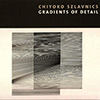 It’s
high time Chiyoko Szlavnics’ sui generis music was committed to record,
so kudos should be extended to musikFabrik & World Edition for this
important release. It includes one of Szlavnics’ most captivating
works, (a)long lines; we’ll draw our own lines; having directed
the UK première of this piece a few years ago, i know all too well the
endemic challenges it presents, particularly the dependence on just
intonation. musikFabrik’s rendition of this & all three works on
this disc is as close to flawless as one’s likely to get, demonstrating
the lovely way Szlavnics melds acoustic & electronic timbres into a
soundworld that’s somewhere in between.
It’s
high time Chiyoko Szlavnics’ sui generis music was committed to record,
so kudos should be extended to musikFabrik & World Edition for this
important release. It includes one of Szlavnics’ most captivating
works, (a)long lines; we’ll draw our own lines; having directed
the UK première of this piece a few years ago, i know all too well the
endemic challenges it presents, particularly the dependence on just
intonation. musikFabrik’s rendition of this & all three works on
this disc is as close to flawless as one’s likely to get, demonstrating
the lovely way Szlavnics melds acoustic & electronic timbres into a
soundworld that’s somewhere in between.[World Edition]
35 | Chvrches – The Bones of What You Believe
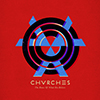 While
most contemporary pop is prepared to do little more than misappropriate
tired tropes from an earlier time, Chvrches strike a perfect balance
between past & future. 80s synth timbres & a fondness for
strong, soaring melodies (borne aloft by Lauren Mayberry’s gorgeous
voice) are as far as the throwbacks go; the rest is all new, songs so
wonderfully exciting it’s as though the band were trying to outdo
themselves with each new track.
While
most contemporary pop is prepared to do little more than misappropriate
tired tropes from an earlier time, Chvrches strike a perfect balance
between past & future. 80s synth timbres & a fondness for
strong, soaring melodies (borne aloft by Lauren Mayberry’s gorgeous
voice) are as far as the throwbacks go; the rest is all new, songs so
wonderfully exciting it’s as though the band were trying to outdo
themselves with each new track.[Amazon | iTunes]
34 | Ulver – Messe I.X-VI.X
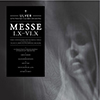 Norway’s
most relentless experimental band have turned to the Tromsø Chamber
Orchestra to help realise their latest project. Like the soundtrack to
some imaginary avant-garde noir movie, Messe I.X-VI.X conjures
up a grayscale spectrum of dramatic spectres, some of which drag one
along with them, while others are intent on surrounding the listener
with a sense of dread. Perhaps a product of the group’s extensive
post-production work, there’s a lightness of touch amidst the gloom that
keeps the album fresh & aerated, allowing the strong emotion
underpinning this heavily wrought music not just to emerge but to
predominate.
Norway’s
most relentless experimental band have turned to the Tromsø Chamber
Orchestra to help realise their latest project. Like the soundtrack to
some imaginary avant-garde noir movie, Messe I.X-VI.X conjures
up a grayscale spectrum of dramatic spectres, some of which drag one
along with them, while others are intent on surrounding the listener
with a sense of dread. Perhaps a product of the group’s extensive
post-production work, there’s a lightness of touch amidst the gloom that
keeps the album fresh & aerated, allowing the strong emotion
underpinning this heavily wrought music not just to emerge but to
predominate.[Amazon | iTunes]
33 | Roly Porter – Life Cycle of a Massive Star
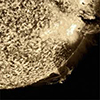 Porter’s follow-up to his 2011 debut Aftertime
goes a long way to consolidating his position as one of the more
ambitious artists working in mainstream electronic music. The title
itself says something of that ambition, & while the album could
never live up to the insane prolixity of hype that surrounded its
release, tracks like ‘Birth’ & ‘Giant’ create a soundworld that is
both vast & overwhelming.
Porter’s follow-up to his 2011 debut Aftertime
goes a long way to consolidating his position as one of the more
ambitious artists working in mainstream electronic music. The title
itself says something of that ambition, & while the album could
never live up to the insane prolixity of hype that surrounded its
release, tracks like ‘Birth’ & ‘Giant’ create a soundworld that is
both vast & overwhelming.[Amazon | Boomkat]
32 | Tomas Phillips/Kenneth Kirschner – Five Transpositions
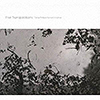 This
fine collaboration utilises a large array of sounds & sources to
create the album’s five pieces. Sometimes the music rattles through
these sources at speed (though never seeming to be doing so at speed),
while elsewhere semi-improvisatory gestures are allowed to play out in a
relatively static way (those well acquainted with Kirschner’s solo work
will recognise this behaviour). ‘Low Bells’ is the standout track, its
assortment of textures cast in the shadow of massive bell resonances.
This
fine collaboration utilises a large array of sounds & sources to
create the album’s five pieces. Sometimes the music rattles through
these sources at speed (though never seeming to be doing so at speed),
while elsewhere semi-improvisatory gestures are allowed to play out in a
relatively static way (those well acquainted with Kirschner’s solo work
will recognise this behaviour). ‘Low Bells’ is the standout track, its
assortment of textures cast in the shadow of massive bell resonances.[Amazon | iTunes]
31 | James Newton Howard – The Hunger Games: Catching Fire (Original Motion Picture Score)
 One of the main things that distinguishes James Newton Howard’s score for the recent Hunger Games
sequel from the shedload of generic soundtracks is his subtle use of
harmony. Whereas most orchestral film scores betray little beyond the
most rudimentary knowledge, Howard here taps into the kind of oblique
tonality upon which many a Shostakovich work was founded. It entirely
suits the movie’s increasingly dark & conflicted character, &
even when the action demands a more pugilistic kind of bombast, Howard
undermines the familiarity through piled-up dissonances & strange
electronic timbres.
One of the main things that distinguishes James Newton Howard’s score for the recent Hunger Games
sequel from the shedload of generic soundtracks is his subtle use of
harmony. Whereas most orchestral film scores betray little beyond the
most rudimentary knowledge, Howard here taps into the kind of oblique
tonality upon which many a Shostakovich work was founded. It entirely
suits the movie’s increasingly dark & conflicted character, &
even when the action demands a more pugilistic kind of bombast, Howard
undermines the familiarity through piled-up dissonances & strange
electronic timbres.[Amazon | iTunes]
30 | Marsheaux –
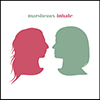 While Greek duo Marsheaux have often been hampered by their heroes, lacking a truly distinctive voice, Inhale emphatically displays what they’re capable of when standing on their own four feet. There are echoes of other acts (The Other Two in particular & a hint of Uh Huh Her)
but what comes across most in these songs is the restless enthusiasm
& talent the pair have for shining synthpop. They don’t even sound
especially retro any longer, which is perhaps testimony enough to how
far they’ve progressed.
While Greek duo Marsheaux have often been hampered by their heroes, lacking a truly distinctive voice, Inhale emphatically displays what they’re capable of when standing on their own four feet. There are echoes of other acts (The Other Two in particular & a hint of Uh Huh Her)
but what comes across most in these songs is the restless enthusiasm
& talent the pair have for shining synthpop. They don’t even sound
especially retro any longer, which is perhaps testimony enough to how
far they’ve progressed.[Undo | iTunes]
29 | Ben Lukas Boysen – Mother Nature
 Boysen taps into a slightly more illuminated soundworld here than the one in his previous soundtrack, last year’s Restive.
As they do in so much of his music (both as himself & as Hecq),
sounds continue to resound within impossibly huge spaces & there are
plenty of glowering deep bass notes & pounding drums. But there’s a
brightness to many of these exquisitely crafted atmospheres that draws
them into altogether more uplifted territory. The film is dark &
threatening, though, & there are few composers better at finding
bold new ways to capture a sense of inscrutable menace.
Boysen taps into a slightly more illuminated soundworld here than the one in his previous soundtrack, last year’s Restive.
As they do in so much of his music (both as himself & as Hecq),
sounds continue to resound within impossibly huge spaces & there are
plenty of glowering deep bass notes & pounding drums. But there’s a
brightness to many of these exquisitely crafted atmospheres that draws
them into altogether more uplifted territory. The film is dark &
threatening, though, & there are few composers better at finding
bold new ways to capture a sense of inscrutable menace.[Amazon | Hymen]
28 | Emmy Rossum – Sentimental Journey
 Rossum’s
first album focussed on original songs characterised by a sense of
blissed out enchantment; her second turns to popular American standards
from the 1920s onward. Each practically sparkles with the invigoratingly
fresh approach Rossum brings to these well-known songs. The
arrangements are quirky & sometimes deliciously unpredictable,
whereas Rossum’s sublime voice is as predictably perfect as ever. Never a
note out of place, she’s not just a delight to listen to, she’s a
marvel.
Rossum’s
first album focussed on original songs characterised by a sense of
blissed out enchantment; her second turns to popular American standards
from the 1920s onward. Each practically sparkles with the invigoratingly
fresh approach Rossum brings to these well-known songs. The
arrangements are quirky & sometimes deliciously unpredictable,
whereas Rossum’s sublime voice is as predictably perfect as ever. Never a
note out of place, she’s not just a delight to listen to, she’s a
marvel.[Amazon | iTunes]
27 | The Knife – Shaking The Habitual
 The
title of this breathtaking album sums up Karin Dreijer Andersson &
Olof Dreijer’s entire approach to music-making. Nothing here is familiar
or workaday: song structures become elastic in their hands, producing
strange & capricious results; melodies wheeze & whine,
meandering all over the place on a whim; accompaniments don’t so much
develop as accrete materials around them; moods are established &
then abruptly shrugged off in favour of something entirely different;
& when it suits, lyrics are ejected entirely in favour of complex
electronic textures. When the result is as sensational as this, it only
makes you wonder why more artists aren’t as open-minded.
The
title of this breathtaking album sums up Karin Dreijer Andersson &
Olof Dreijer’s entire approach to music-making. Nothing here is familiar
or workaday: song structures become elastic in their hands, producing
strange & capricious results; melodies wheeze & whine,
meandering all over the place on a whim; accompaniments don’t so much
develop as accrete materials around them; moods are established &
then abruptly shrugged off in favour of something entirely different;
& when it suits, lyrics are ejected entirely in favour of complex
electronic textures. When the result is as sensational as this, it only
makes you wonder why more artists aren’t as open-minded.[Amazon | Boomkat]
26 | Cliff Martinez – Only God Forgives (Original Motion Picture Soundtrack) [Deluxe Edition]
 Blunt,
brutish, ritualistic, occasionally mitigated by moments of forced &
uncomfortable sensuality. That description could apply as much to Nicolas Winding Refn’s film
(another of my favourites) as to Cliff Martinez’s superbly-judged
score. Tribal drums are answered by a glass harmonica, soft strings by
deep Tibetan horns, interspersed with performances of Thai
karaoke—tense, jarring juxtapositions that find some kind of release in
the synth-laden explosion of core track ‘Wanna Fight’. As soundtracks
go, this is surely one of the most original & troublingly effective
of recent years.
Blunt,
brutish, ritualistic, occasionally mitigated by moments of forced &
uncomfortable sensuality. That description could apply as much to Nicolas Winding Refn’s film
(another of my favourites) as to Cliff Martinez’s superbly-judged
score. Tribal drums are answered by a glass harmonica, soft strings by
deep Tibetan horns, interspersed with performances of Thai
karaoke—tense, jarring juxtapositions that find some kind of release in
the synth-laden explosion of core track ‘Wanna Fight’. As soundtracks
go, this is surely one of the most original & troublingly effective
of recent years.[Amazon | iTunes]
25 | Motion Sickness of Time Travel – Eclipse Studies
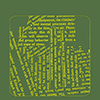 It’s
been an almost absurdly productive 2013 for Rachel Evans (around 10
releases), somewhat militated against by their mixed & inconsistent
quality. But Eclipse Studies would have made the year
worthwhile by itself, a pair of equal-length, large-form pieces filled
with a highly engaging & variegated collection of musical swatches.
It’s a kind of compendium of ideas, by turns playful, distant, dogmatic,
emulatory—all of it suffused with Evans’ characteristically light,
whimsically effervescent style.
It’s
been an almost absurdly productive 2013 for Rachel Evans (around 10
releases), somewhat militated against by their mixed & inconsistent
quality. But Eclipse Studies would have made the year
worthwhile by itself, a pair of equal-length, large-form pieces filled
with a highly engaging & variegated collection of musical swatches.
It’s a kind of compendium of ideas, by turns playful, distant, dogmatic,
emulatory—all of it suffused with Evans’ characteristically light,
whimsically effervescent style.[Motion Sickness of Time Travel]
24 | Rashad Becker – Traditional Music of Notional Species Vol. I
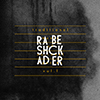 Listening
to this, it beggers belief that it’s a debut album. Yet Rashad Becker,
renowned for his work as engineer at Berlin’s equally renowned Dubplates
& Mastering, has clearly been formulating & honing his ideas
about sound for some time. The results are as astonishing as they were
highly anticipated; the way in which Becker contrives both to synthesise
instrumental & vocal timbres from scratch & then make them jump
through his own series of decidedly taxing & contorted hoops is one
of the most unique things i’ve heard in a very long time.
Listening
to this, it beggers belief that it’s a debut album. Yet Rashad Becker,
renowned for his work as engineer at Berlin’s equally renowned Dubplates
& Mastering, has clearly been formulating & honing his ideas
about sound for some time. The results are as astonishing as they were
highly anticipated; the way in which Becker contrives both to synthesise
instrumental & vocal timbres from scratch & then make them jump
through his own series of decidedly taxing & contorted hoops is one
of the most unique things i’ve heard in a very long time.[Boomkat | iTunes]
23 | Nine Inch Nails – Hesitation Marks (Audiophile Mastered Version)
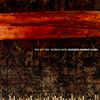 Being
a lifelong fan of Nine Inch Nails, i’ll admit to having had misgivings
about this album prior to listening. What now for the man who once felt
little more than endless rage at the world, but is now clearly so happy
& contented? Hesitation Marks doesn’t quite answer that
question; the traces of anger are softened, the subject matter more
wide-ranging & mellowed—in many ways this doesn’t seem like the NIN
we’ve known & loved (& sympathised with). But Trent Reznor is a
powerhouse of conceptual & technical ingenuity, & despite one’s
reservations, this is a supremely impressive album that somehow keeps
the NIN continuity intact.
Being
a lifelong fan of Nine Inch Nails, i’ll admit to having had misgivings
about this album prior to listening. What now for the man who once felt
little more than endless rage at the world, but is now clearly so happy
& contented? Hesitation Marks doesn’t quite answer that
question; the traces of anger are softened, the subject matter more
wide-ranging & mellowed—in many ways this doesn’t seem like the NIN
we’ve known & loved (& sympathised with). But Trent Reznor is a
powerhouse of conceptual & technical ingenuity, & despite one’s
reservations, this is a supremely impressive album that somehow keeps
the NIN continuity intact.[NIN]
22 | Flat Earth Society –
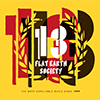 It’s
tempting to ask yourself whether it’s jazz you’re hearing or if
someone’s just taking the piss. In truth, it seems to be both &
neither: by thumbing their nose to convention, Flat Earth Society create
some the most bewildering but thrilling leftfield jazz homages you’ll
ever hear. The sensibility of Zappa (think Make a Jazz Noise Here)
seems to be the guiding light, causing the music to shift abruptly
between big band tuttis, faux eastern melodic interludes, rock music
outbursts & plenty of other stuff that defies any kind of meaningful
description. Wonderful.
It’s
tempting to ask yourself whether it’s jazz you’re hearing or if
someone’s just taking the piss. In truth, it seems to be both &
neither: by thumbing their nose to convention, Flat Earth Society create
some the most bewildering but thrilling leftfield jazz homages you’ll
ever hear. The sensibility of Zappa (think Make a Jazz Noise Here)
seems to be the guiding light, causing the music to shift abruptly
between big band tuttis, faux eastern melodic interludes, rock music
outbursts & plenty of other stuff that defies any kind of meaningful
description. Wonderful.[Amazon | iTunes]
21 | CocoRosie – Tales of a Grass Widow
 Those familiar with CocoRosie’s output know to expect the unexpected, but that didn’t prevent Tales of a Grass Widow
from packing two fists’ worth of unseen punches. Introducing quirky
sporadic use of autotune only makes the girls sound even more out there
than usual, but the real surprise (for me at least) is how these songs
nonetheless seem utterly grounded, rooted in a kind of seriousness
belied by the all the timbral/textural/structural/vocal eccentricities.
Never, in fact, have they sounded more pensive & developed than
here; how they manage this while executing all manner of stylistic
twirls & coquettish whispers is anyone’s guess.
Those familiar with CocoRosie’s output know to expect the unexpected, but that didn’t prevent Tales of a Grass Widow
from packing two fists’ worth of unseen punches. Introducing quirky
sporadic use of autotune only makes the girls sound even more out there
than usual, but the real surprise (for me at least) is how these songs
nonetheless seem utterly grounded, rooted in a kind of seriousness
belied by the all the timbral/textural/structural/vocal eccentricities.
Never, in fact, have they sounded more pensive & developed than
here; how they manage this while executing all manner of stylistic
twirls & coquettish whispers is anyone’s guess.[Amazon | iTunes]
20 | Ryoji Ikeda –
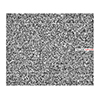 Ikeda’s
stark exploration of humanity’s increasing interaction with—&
dependence upon—the movement of data has found perhaps its most engaging
expression in supercodex. On some previous albums (matrix & test pattern
spring to mind), his approach has felt so rigorous, & so
concomitantly aloof, that the electronics seem entirely bereft of the
human touch. Not so here: playfulness dominates Ikeda’s manipulations,
causing the raw sine tones & noise clusters continually to reform
themselves into irresistible beat patterns & even semblances of
basslines. It’ll still give your ears & your speakers a hell of a
pounding, but Ikeda’s arguably never made the experience so much fun.
Ikeda’s
stark exploration of humanity’s increasing interaction with—&
dependence upon—the movement of data has found perhaps its most engaging
expression in supercodex. On some previous albums (matrix & test pattern
spring to mind), his approach has felt so rigorous, & so
concomitantly aloof, that the electronics seem entirely bereft of the
human touch. Not so here: playfulness dominates Ikeda’s manipulations,
causing the raw sine tones & noise clusters continually to reform
themselves into irresistible beat patterns & even semblances of
basslines. It’ll still give your ears & your speakers a hell of a
pounding, but Ikeda’s arguably never made the experience so much fun.[Amazon | Boomkat]
19 | Autechre –
 Exai
finds Sean Booth & Rob Brown getting back to basics. The
hat-tipping to ambient softness, a recurring feature of their work since
Quaristice, is essentially gone, replaced with chrome-plated
beat machinations of fabulous complexity. Combined with a renewed
interest in large-form evolutionary structures, Exai represents some of their most strikingly challenging work since Untilted.
Exai
finds Sean Booth & Rob Brown getting back to basics. The
hat-tipping to ambient softness, a recurring feature of their work since
Quaristice, is essentially gone, replaced with chrome-plated
beat machinations of fabulous complexity. Combined with a renewed
interest in large-form evolutionary structures, Exai represents some of their most strikingly challenging work since Untilted.[Bleep | iTunes]
18 | How To Destroy Angels – Welcome oblivion
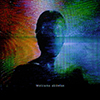 Trent
Reznor’s latest project—featuring his wife Mariqueen Maandig as
vocalist—was perhaps always going to be seen & heard in parallel to
Nine Inch Nails. In practice, while Reznor’s sonic fingerprints are all
over HTDA’s music, there’s a softness & a form of vulnerability here
that markedly distinguishes itself from the NIN soundworld. What these
songs betray most, though, is elegance; the intricate textures that
surround & reinforce Maandig’s voice—clearly the product of intense
studio labours—feel nothing less than sculptural.
Trent
Reznor’s latest project—featuring his wife Mariqueen Maandig as
vocalist—was perhaps always going to be seen & heard in parallel to
Nine Inch Nails. In practice, while Reznor’s sonic fingerprints are all
over HTDA’s music, there’s a softness & a form of vulnerability here
that markedly distinguishes itself from the NIN soundworld. What these
songs betray most, though, is elegance; the intricate textures that
surround & reinforce Maandig’s voice—clearly the product of intense
studio labours—feel nothing less than sculptural.[Amazon | HTDA]
17 | Secret Chiefs 3 – Book Of Souls Folio A
 It
isn’t often one gets to hear such diverse elements as pimped up Turkish
music, experimental electronics, faux radio jingles, French-inflected
post-rock, arrangements of ’70s horror themes & ’60s crooners,
ritualised orchestral tomfoolery & MoR road music on one album. The
reason for such a potentially schizoid release is due to it encompassing
no fewer than six of Trey Spruance’s compositional identities. However, Book Of Souls Folio A
doesn’t merely hang together but actively clarifies the points of
connection & continuity within Spruance’s outlook; the range of his
imagination is simply stunning.
It
isn’t often one gets to hear such diverse elements as pimped up Turkish
music, experimental electronics, faux radio jingles, French-inflected
post-rock, arrangements of ’70s horror themes & ’60s crooners,
ritualised orchestral tomfoolery & MoR road music on one album. The
reason for such a potentially schizoid release is due to it encompassing
no fewer than six of Trey Spruance’s compositional identities. However, Book Of Souls Folio A
doesn’t merely hang together but actively clarifies the points of
connection & continuity within Spruance’s outlook; the range of his
imagination is simply stunning.[Amazon | iTunes]
16 | Liza Lim – Tongue of the Invisible
 Reviewed back in October,
the single work on this disc is a hugely successful testament to the
ways in which improvised music can integrate fully with pre-composed
material. As an example of what Lim has called an “ecology of
collaboration” it’s impressive enough, but Lim’s ear for surprising
sonorities is remarkable, & on top of all that Tongue of the Invisible is both thrillingly dramatic & deeply sensual.
Reviewed back in October,
the single work on this disc is a hugely successful testament to the
ways in which improvised music can integrate fully with pre-composed
material. As an example of what Lim has called an “ecology of
collaboration” it’s impressive enough, but Lim’s ear for surprising
sonorities is remarkable, & on top of all that Tongue of the Invisible is both thrillingly dramatic & deeply sensual.[Amazon | iTunes]
15 | Michael Finnissy – The History of Photography in Sound
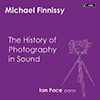 Completely
immersed? Check. Out of my depth? Pretty much. But then, it’s hard not
to find oneself lost—in both senses of the word—listening to Finnissy’s
5½-hour magnum opus for solo piano, yet that only makes the experience
all the more exhilarating. Everything about this release is extreme:
Finnissy’s relentless compositional invention, Ian Pace’s frankly
flabbergasting technique, & his fascinating book-length programme
notes—which, once you make it past your tl;dr
gag reflex are phenomenally useful. It’s an astounding, revelatory
work, & this release is nothing less than a milestone in the history
of both composition & recorded music. Essential.
Completely
immersed? Check. Out of my depth? Pretty much. But then, it’s hard not
to find oneself lost—in both senses of the word—listening to Finnissy’s
5½-hour magnum opus for solo piano, yet that only makes the experience
all the more exhilarating. Everything about this release is extreme:
Finnissy’s relentless compositional invention, Ian Pace’s frankly
flabbergasting technique, & his fascinating book-length programme
notes—which, once you make it past your tl;dr
gag reflex are phenomenally useful. It’s an astounding, revelatory
work, & this release is nothing less than a milestone in the history
of both composition & recorded music. Essential.[Presto Classical | Divine Art]
14 | These New Puritans – Field of Reeds
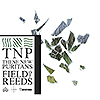 Three years have passed since Hidden,
but this album reinforces further how far & wide Jack Barnett’s
interests lie. Affording himself the riches of additional instrumental
& vocal ensembles seems to have unleashed a hitherto tethered scale
of ambition. The worlds of pop & rock have never sounded so distant,
so irrelevant; Field of Reeds is not so much an album than a contemporary song cycle—can These New Puritans really be described as a ‘band’ any more?
Three years have passed since Hidden,
but this album reinforces further how far & wide Jack Barnett’s
interests lie. Affording himself the riches of additional instrumental
& vocal ensembles seems to have unleashed a hitherto tethered scale
of ambition. The worlds of pop & rock have never sounded so distant,
so irrelevant; Field of Reeds is not so much an album than a contemporary song cycle—can These New Puritans really be described as a ‘band’ any more?[Amazon | iTunes]
13 | Igor Stravinsky – Le Sacre du Printemps (Simon Rattle/Berlin Philharmoniker)
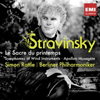 Perhaps it was inevitable in this 100th anniversary year of the Rite of Spring
that it would fall to Simon Rattle—one of music’s most perspicacious of
conductors—to break through a century of gradual over-familiarity &
find the essence of what caused such havoc in the first place. Le Sacre
still sounds as though it could have been written last week rather than
last century, even more so when one hears with such clarity the strange
counterpoint, the seeming non-sequitur chord progressions & such
wildly Dionysian orchestral pile-ups. With the Berlin Phil, Rattle has
enabled the Rite to sound entirely fresh for the century that lies ahead.
Perhaps it was inevitable in this 100th anniversary year of the Rite of Spring
that it would fall to Simon Rattle—one of music’s most perspicacious of
conductors—to break through a century of gradual over-familiarity &
find the essence of what caused such havoc in the first place. Le Sacre
still sounds as though it could have been written last week rather than
last century, even more so when one hears with such clarity the strange
counterpoint, the seeming non-sequitur chord progressions & such
wildly Dionysian orchestral pile-ups. With the Berlin Phil, Rattle has
enabled the Rite to sound entirely fresh for the century that lies ahead.[Presto Classical | Amazon]
12 | Bloodgroup – Tracing Echoes
 While
it’s unfortunate that so many Nordic acts get saddled with the epithet
‘quirky’, both of Bloodgroup’s previous albums would qualify. But not Tracing Echoes,
which will inevitably be looked back on as a turning point in their
career. The songs are as gymnastic as ever, but now underpinned by
pretty no-nonsense, heavyweight basslines & beat patterns, &
they’ve coloured their palette (like the cover artwork) with a black
& white selection of hard edges & buzzy sonics. Earnest yet
energetic, Tracing Echoes surely elevates Bloodgroup to the status of Iceland’s best group.
While
it’s unfortunate that so many Nordic acts get saddled with the epithet
‘quirky’, both of Bloodgroup’s previous albums would qualify. But not Tracing Echoes,
which will inevitably be looked back on as a turning point in their
career. The songs are as gymnastic as ever, but now underpinned by
pretty no-nonsense, heavyweight basslines & beat patterns, &
they’ve coloured their palette (like the cover artwork) with a black
& white selection of hard edges & buzzy sonics. Earnest yet
energetic, Tracing Echoes surely elevates Bloodgroup to the status of Iceland’s best group.[Amazon | iTunes]
11 | Black Swan –
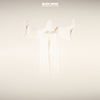 Black
Swan’s ongoing obsession with the subtleties to be found deep within
the noise & fuzz of aged recordings continues to yield fascinating
results. Redemption is in many ways a brighter survey; it does
plumb the depths, but that’s not at all the focus of attention on this
occasion. Neither do Black Swan afford the listener as much opportunity
to reach into the abstract; both the choice of source materials &
the way they’ve been treated emphasises clarity & the particular
kind of poignant beauty that emerges from the best & most honest
hauntological objects.
Black
Swan’s ongoing obsession with the subtleties to be found deep within
the noise & fuzz of aged recordings continues to yield fascinating
results. Redemption is in many ways a brighter survey; it does
plumb the depths, but that’s not at all the focus of attention on this
occasion. Neither do Black Swan afford the listener as much opportunity
to reach into the abstract; both the choice of source materials &
the way they’ve been treated emphasises clarity & the particular
kind of poignant beauty that emerges from the best & most honest
hauntological objects.[Black Swan]
10 | Aidan Baker & Troum – Nihtes Niht
 Having
tread the safest of waters for some time, Aidan Baker has hit the
jackpot in this splendid collaboration with Troum. Drones, not
surprisingly, are the lynchpin of this joint project, but drones that
are festooned in a fabulous array of colours & atmospheres, passing
between close intimacy (falling to almost sub-audibility in the process)
& vast reverberant spaces, examining dense noise & allowing
quasi-tonal chords to coalesce out of drifting pitches. Heady, involving
stuff that makes the case for the continuing power of drone music.
Having
tread the safest of waters for some time, Aidan Baker has hit the
jackpot in this splendid collaboration with Troum. Drones, not
surprisingly, are the lynchpin of this joint project, but drones that
are festooned in a fabulous array of colours & atmospheres, passing
between close intimacy (falling to almost sub-audibility in the process)
& vast reverberant spaces, examining dense noise & allowing
quasi-tonal chords to coalesce out of drifting pitches. Heady, involving
stuff that makes the case for the continuing power of drone music.[Broken Spine Productions]
9 | iamamiwhoami –
 Arguably
the best, certainly one of the most ludicrously imaginative artists to
have emerged from Scandinavia in recent years, Jonna Lee’s second album
is more considered than last year’s kin, but is essentially as
carefree as ever. Indeed, some of the songs—’u-2′ especially—let rip
with the most joyous abandon, yet as a whole the pace is slowed, the
tone reflective. Not many can get away with that attitude atop ceaseless
analogue synth arpeggios, but then iamamiwhoami is without doubt the
most unique voice in contemporary electronica.
Arguably
the best, certainly one of the most ludicrously imaginative artists to
have emerged from Scandinavia in recent years, Jonna Lee’s second album
is more considered than last year’s kin, but is essentially as
carefree as ever. Indeed, some of the songs—’u-2′ especially—let rip
with the most joyous abandon, yet as a whole the pace is slowed, the
tone reflective. Not many can get away with that attitude atop ceaseless
analogue synth arpeggios, but then iamamiwhoami is without doubt the
most unique voice in contemporary electronica.[towhomitmayconcern | iTunes]
8 | Paul Jebanasam –
 In
such a secular world as that of contemporary music, the place &
role of symbols & rituals has attained a new form of significance.
Paul Jebanasam has channelled deeply into that most modern mindset; in my review of Rites a couple of months ago, i remarked how it is “like a five-part liturgy to an unknown god or force”. Certainly the way Rites
unfolds has all the structural patience of a liturgy, only gradually
moving into its dark, passionate core, a veritable blizzard of
resounding echoes & melodic keening.
In
such a secular world as that of contemporary music, the place &
role of symbols & rituals has attained a new form of significance.
Paul Jebanasam has channelled deeply into that most modern mindset; in my review of Rites a couple of months ago, i remarked how it is “like a five-part liturgy to an unknown god or force”. Certainly the way Rites
unfolds has all the structural patience of a liturgy, only gradually
moving into its dark, passionate core, a veritable blizzard of
resounding echoes & melodic keening.[Amazon | Boomkat]
7 | irr. app. (ext.) –
 Matt
Waldron’s music has a tendency to linger at the liminal point between
eccentricity & outright absurdity. This album interestingly draws
away from both, presenting instead a more serious soundscape. Waldron
handles sound the way a magician might use a cauldron; scraps of ideas
from a myriad sources are thrown into the pot sometimes on a whim,
sometimes to steep & transform the nature of the whole. In the case
of Tuberpendicular, the choice of sounds is as tantalisingly
anecdotal as ever: almost nothing sounds synthetic, & the resulting
smorgasbord of unrelated, almost identifiable sources impacting off each
other makes for an absolutely fascinating aural journey.
Matt
Waldron’s music has a tendency to linger at the liminal point between
eccentricity & outright absurdity. This album interestingly draws
away from both, presenting instead a more serious soundscape. Waldron
handles sound the way a magician might use a cauldron; scraps of ideas
from a myriad sources are thrown into the pot sometimes on a whim,
sometimes to steep & transform the nature of the whole. In the case
of Tuberpendicular, the choice of sounds is as tantalisingly
anecdotal as ever: almost nothing sounds synthetic, & the resulting
smorgasbord of unrelated, almost identifiable sources impacting off each
other makes for an absolutely fascinating aural journey.[irr. app. (ext.)]
6 | Stephan Mathieu – The Falling Rocket
 In
a year that saw practically no ambient music of quality, Stephan
Mathieu consistently proves that the genre yet has life. Chords hang,
melodies slowly form, deep clusters judder at length, motes of material
appear & drift—none of this is new, of course, but Mathieu imbues
these nine pieces with such interest & beauty it’s as though he was
inventing ambient anew. The music has a transfixed, ecstatic quality,
& that’s precisely the effect it has on the listener. Really
gorgeous stuff.
In
a year that saw practically no ambient music of quality, Stephan
Mathieu consistently proves that the genre yet has life. Chords hang,
melodies slowly form, deep clusters judder at length, motes of material
appear & drift—none of this is new, of course, but Mathieu imbues
these nine pieces with such interest & beauty it’s as though he was
inventing ambient anew. The music has a transfixed, ecstatic quality,
& that’s precisely the effect it has on the listener. Really
gorgeous stuff.[Schwebung | iTunes]
5 | Jakob Ullmann – fremde zeit addendum 4
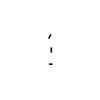 Once
upon a time i found it hard to write about Ullmann’s music; now i feel
as though i can hardly shut up about it. The single work included on
this release—solo III für orgel—continues the argument &
practice established in last year’s 3-disc bonanza. Back in May, i
described the work’s lengthy drones as “deeply etched grooves within the
performance space, a kind of simple grain upon & about which utmost
delicate moments of tracery are imposed”. The more time one spends with
the piece, the more these very occasional flurries of barely noticeable
activity become moments of the profoundest significance. It’s an
astonishingly vivid demonstration of Ullmann’s observation that “The
less loud music is, the better I can hear it”.
Once
upon a time i found it hard to write about Ullmann’s music; now i feel
as though i can hardly shut up about it. The single work included on
this release—solo III für orgel—continues the argument &
practice established in last year’s 3-disc bonanza. Back in May, i
described the work’s lengthy drones as “deeply etched grooves within the
performance space, a kind of simple grain upon & about which utmost
delicate moments of tracery are imposed”. The more time one spends with
the piece, the more these very occasional flurries of barely noticeable
activity become moments of the profoundest significance. It’s an
astonishingly vivid demonstration of Ullmann’s observation that “The
less loud music is, the better I can hear it”.[Presto Classical | Amazon]
4 | Xopher Davidson + Zbigniew Karkowski –
 In
a year that was largely spared significant compositional losses, the
death of Zbigniew Karkowski earlier this month (at the age of only 55)
came as a shock & a blow. All the more so when confronted by the
music in this monumental collaboration. Imagine if the monolith from
Stanley Kubrick’s 2001 began to emit sound, & you’ll come close to
what Processor is like: an unstoppable stream of calm but
resolute noise, throb & shimmer. The way it captures a sense of the
numinous lends it an ineffable quality that’s rare in contemporary
electronic music. In just 43 minutes, Davidson & Karkowski tap into
something absolute & everywhere.
In
a year that was largely spared significant compositional losses, the
death of Zbigniew Karkowski earlier this month (at the age of only 55)
came as a shock & a blow. All the more so when confronted by the
music in this monumental collaboration. Imagine if the monolith from
Stanley Kubrick’s 2001 began to emit sound, & you’ll come close to
what Processor is like: an unstoppable stream of calm but
resolute noise, throb & shimmer. The way it captures a sense of the
numinous lends it an ineffable quality that’s rare in contemporary
electronic music. In just 43 minutes, Davidson & Karkowski tap into
something absolute & everywhere.[Amazon | Boomkat]
3 | Main –
 Robert
Hampson’s decision to revivify his Main project, following a seven year
gap, has produced what is far & away the most brilliant electronic
work of the year. The only gripe is that, at 46 minutes, it feels so
short, but that’s simply a reaction to the astounding level of expertise
& invention captured in each of the album’s four tracks. Hampson’s
aural melting pot contains a huge variety of elements, essential in
order to fashion such kaleidoscopically shifting textures as these.
Robert
Hampson’s decision to revivify his Main project, following a seven year
gap, has produced what is far & away the most brilliant electronic
work of the year. The only gripe is that, at 46 minutes, it feels so
short, but that’s simply a reaction to the astounding level of expertise
& invention captured in each of the album’s four tracks. Hampson’s
aural melting pot contains a huge variety of elements, essential in
order to fashion such kaleidoscopically shifting textures as these.[Boomkat | iTunes]
2 | The Mount Fuji Doomjazz Corporation –
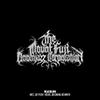 Honestly, it’s tempting to think that The Mount Fuji Doomjazz Corporation can simply do no wrong. Two years ago, on Anthropomorphic (my best album of 2011)
they defined fin de siècle jazz; now, in this live performance from the
Roadburn festival, they’ve reached far beyond it into a
post-apocalyptic hinterland. Such a wasted musical context as this can
only bestow on the vestiges of melody a dignity & majesty of the
heaviest kind. Ultimately, as i noted in my review in October,
the piece results in “a musical & an emotional tabula rasa”; having
wiped the slate clean, one can scarcely imagine where they’ll go next.
Honestly, it’s tempting to think that The Mount Fuji Doomjazz Corporation can simply do no wrong. Two years ago, on Anthropomorphic (my best album of 2011)
they defined fin de siècle jazz; now, in this live performance from the
Roadburn festival, they’ve reached far beyond it into a
post-apocalyptic hinterland. Such a wasted musical context as this can
only bestow on the vestiges of melody a dignity & majesty of the
heaviest kind. Ultimately, as i noted in my review in October,
the piece results in “a musical & an emotional tabula rasa”; having
wiped the slate clean, one can scarcely imagine where they’ll go next.[The Mount Fuji Doomjazz Corporation | iTunes]

1 | Philippe Petit – Needles in Pain
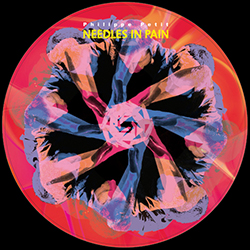 Masterpieces
aren’t always obvious, but within just the first few seconds of
Philippe Petit’s acousmatic tour-de-force, it was abundantly clear that
this was something seriously special. In a way, Needles in Pain
is something of an existential musical experience, an examination
simultaneously of the practices of recording & playing back sound.
Turntables have long been the locus of Petit’s attention, & his 2010
collaboration with Cosey Fanny Tutti, Mist While Sleeping / Invisible Whispers,
made the heavily-worn aspects of vinyl playback an integral component
in his compositional palette. Here, it’s as though we have personally
been integrated into the mechanism (an experience greatly
enhanced—almost too much—through headphones), finding ourselves betwixt
gigantic styluses, scurrying over scuffed vinyl surfaces, in the process
contributing directly to the maelstrom of glitches, pops &
scratches that pepper the clamorous, immovable clouds of noise &
blasts of more concrete material that become periodically perceptible.
Masterpieces
aren’t always obvious, but within just the first few seconds of
Philippe Petit’s acousmatic tour-de-force, it was abundantly clear that
this was something seriously special. In a way, Needles in Pain
is something of an existential musical experience, an examination
simultaneously of the practices of recording & playing back sound.
Turntables have long been the locus of Petit’s attention, & his 2010
collaboration with Cosey Fanny Tutti, Mist While Sleeping / Invisible Whispers,
made the heavily-worn aspects of vinyl playback an integral component
in his compositional palette. Here, it’s as though we have personally
been integrated into the mechanism (an experience greatly
enhanced—almost too much—through headphones), finding ourselves betwixt
gigantic styluses, scurrying over scuffed vinyl surfaces, in the process
contributing directly to the maelstrom of glitches, pops &
scratches that pepper the clamorous, immovable clouds of noise &
blasts of more concrete material that become periodically perceptible.In fact, to continue the existential thread, so much does Petit make the music as a whole feel like the spontaneous consequent of our own unwitting participation that it begs the question of whether any of this material can be heard as diegetic. That’s imaginary, obviously, but regardless, it doesn’t prevent a fundamental undermining of the concepts of composer, performer & listener; indeed, it challenges us directly to find our place & our role—or, more likely, on further listenings, multiple places & roles—with respect to Petit’s inscrutable material. i don’t know if i’ve ever heard an album with the ability to provoke such intense inner conflict as this, or to force such a re-evaluation of the entire music-making/-listening experiences. As such, Needles in Pain is unique & amazing, & easily my best album of 2013.
[Philippe Petit | Alrealon Musique]
So, having listened to no fewer than 261 EPs & albums released this year, it’s time to distil that listening into the annual Best of the Year lists. As always, we’ll start with the ten most exceptional EPs.
10 | Gazelle Twin –
 Elizabeth Walling’s first release of new material since 2011′s dazzling The Entire City
contains a trio of songs plus a quartet of remixes. The former are
deeply impressive; ‘I Turn My Arm’ may well be her most impassioned song
to date, all the more far-reaching due to emerging out of Walling’s
characteristic sedate solemnity. As for the latter, unlike pretty much
all examples today these remixes are well worth hearing, sensitive
re-interpretations that tease out fresh aspects of the originals.
Elizabeth Walling’s first release of new material since 2011′s dazzling The Entire City
contains a trio of songs plus a quartet of remixes. The former are
deeply impressive; ‘I Turn My Arm’ may well be her most impassioned song
to date, all the more far-reaching due to emerging out of Walling’s
characteristic sedate solemnity. As for the latter, unlike pretty much
all examples today these remixes are well worth hearing, sensitive
re-interpretations that tease out fresh aspects of the originals.[Juno Download]
9 | Braids – In Kind // Amends
 Braids
have a rather exciting habit of playing cat & mouse with singer
Raphaelle Standell-Preston’s voice. In many ways, she’s a new Elizabeth
Fraser (yes, she really is that good), but many’s the time when the band
keeps that to itself, subduing the vocals or peppering them with
jolting electronica. When let loose, though, Braids’ songs attain the
kind of soaring delirium few groups can match. ‘In Kind’ captures this
best, transforming itself from aspirational verses to a vision-filled
chorus at gloriously unexpected altitude.
Braids
have a rather exciting habit of playing cat & mouse with singer
Raphaelle Standell-Preston’s voice. In many ways, she’s a new Elizabeth
Fraser (yes, she really is that good), but many’s the time when the band
keeps that to itself, subduing the vocals or peppering them with
jolting electronica. When let loose, though, Braids’ songs attain the
kind of soaring delirium few groups can match. ‘In Kind’ captures this
best, transforming itself from aspirational verses to a vision-filled
chorus at gloriously unexpected altitude.[Arbutus | Boomkat]
8 | Jefre Cantu-Ledesma –
 An
outstanding example of how to frame an argument within the context of
noise & scrunch, & then to transcend it entirely. Forcing
material to fend for itself in fields of harsh disjecta membra is
commonplace almost to the point of cliché nowadays, but Cantu-Ledesma
somehow makes the two elements feel interdependent. This symbiosis
emphasises the beauty of each aspect, resulting in some of the most
strikingly original & graceful ambient music not just in 2013 but of
recent years.
An
outstanding example of how to frame an argument within the context of
noise & scrunch, & then to transcend it entirely. Forcing
material to fend for itself in fields of harsh disjecta membra is
commonplace almost to the point of cliché nowadays, but Cantu-Ledesma
somehow makes the two elements feel interdependent. This symbiosis
emphasises the beauty of each aspect, resulting in some of the most
strikingly original & graceful ambient music not just in 2013 but of
recent years.[Boomkat]
7 | Yugen – Observations On Trance Or Human Hybernation
 David
Sani’s latest creation meditates on source materials culled from
self-hypnosis recordings. That suggests soft restraint, but Sani whips
up these sources into a dense, polyvalent texturescape, passing through
noisy clouds of obfuscation, passages of obliquely audible speech,
industrial-strength static clusters, near silences & mesmerising
drones. Not so much episodic as evolutionary, it’s Sani’s most
wide-ranging & inventive work to date.
David
Sani’s latest creation meditates on source materials culled from
self-hypnosis recordings. That suggests soft restraint, but Sani whips
up these sources into a dense, polyvalent texturescape, passing through
noisy clouds of obfuscation, passages of obliquely audible speech,
industrial-strength static clusters, near silences & mesmerising
drones. Not so much episodic as evolutionary, it’s Sani’s most
wide-ranging & inventive work to date.[Yugen Art - free download]
6 | Christopher McFall – Quivering into your blood night radio
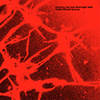 McFall’s
work seems more like the product of a sonic blacksmith than anything
else, & his latest release only reinforces that impression. This
time his attention is focussed on field recordings of the atmosphere
& activity of Kansas City’s Union Station, forging from them another
impossibly dark, nocturnal study. McFall’s ability to unsettle comes
not from the merely theatrical affectations of dark ambience but by
tapping into the inherently uncanny qualities of his materials. It
pervades both pieces on this EP, some of which resound as if from a
bottomless pit, others seemingly emerging out of one’s own head.
McFall’s
work seems more like the product of a sonic blacksmith than anything
else, & his latest release only reinforces that impression. This
time his attention is focussed on field recordings of the atmosphere
& activity of Kansas City’s Union Station, forging from them another
impossibly dark, nocturnal study. McFall’s ability to unsettle comes
not from the merely theatrical affectations of dark ambience but by
tapping into the inherently uncanny qualities of his materials. It
pervades both pieces on this EP, some of which resound as if from a
bottomless pit, others seemingly emerging out of one’s own head.[Impulsive Habitat - free download]
5 | Access to Arasaka – écrasez l’infâme
 One
of the masters of contemporary glitchtronics, Rob Lioy’s only release
of 2013 occupies a more meditative space than much of his previous work.
It takes a while to make its mark, but the latter half of this 6-track
EP positively burns with intensity, moving from a scalding semi-stasis
into the kind of rug-pulling beatcraft for which Access to Arasaka is
justly renowned. Yet the emphasis here is on rich, ominous clouds of
nebulosity, an aspect Lioy has hitherto usually kept in the background.
Considering the question posed by the album’s accompanying notes—”What
infamous thing do you wish to eradicate?”—this shift in focus perhaps
foretells interesting developments for 2014.
One
of the masters of contemporary glitchtronics, Rob Lioy’s only release
of 2013 occupies a more meditative space than much of his previous work.
It takes a while to make its mark, but the latter half of this 6-track
EP positively burns with intensity, moving from a scalding semi-stasis
into the kind of rug-pulling beatcraft for which Access to Arasaka is
justly renowned. Yet the emphasis here is on rich, ominous clouds of
nebulosity, an aspect Lioy has hitherto usually kept in the background.
Considering the question posed by the album’s accompanying notes—”What
infamous thing do you wish to eradicate?”—this shift in focus perhaps
foretells interesting developments for 2014.[CRL Studios]
4 | Autechre –
 The boys are back with four tracks that in some ways return to the kind of elliptical elongations heard on 2005′s Untilted.
They share that album’s strong sense of momentum & clear surface
evolution, the beats emerging as if through multiple layers of filtering
gauze. However, the brevity of these tracks bolsters their directness,
projecting clarity & immediacy despite the music’s abundant inner
complexities.
The boys are back with four tracks that in some ways return to the kind of elliptical elongations heard on 2005′s Untilted.
They share that album’s strong sense of momentum & clear surface
evolution, the beats emerging as if through multiple layers of filtering
gauze. However, the brevity of these tracks bolsters their directness,
projecting clarity & immediacy despite the music’s abundant inner
complexities.[Bleep]
3 | voidesque – the water test
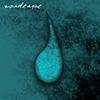 Since
his first release at the start of last year, Derek Jeppsen has become
one of the most interesting figures in experimental IDM. Although still a
relatively unknown voice, that situation may well change after an
extremely productive 2013, which saw no fewer than half a dozen releases
(all freely available). His music is for the most part concise &
concentrated, & while the three tracks on the water test
together last barely 10 minutes, the amount of invention piled into
them, combined with Jeppsen’s increasing propensity toward unchecked
aggression, makes them powerful & cutting.
Since
his first release at the start of last year, Derek Jeppsen has become
one of the most interesting figures in experimental IDM. Although still a
relatively unknown voice, that situation may well change after an
extremely productive 2013, which saw no fewer than half a dozen releases
(all freely available). His music is for the most part concise &
concentrated, & while the three tracks on the water test
together last barely 10 minutes, the amount of invention piled into
them, combined with Jeppsen’s increasing propensity toward unchecked
aggression, makes them powerful & cutting.[self-release - free download]
2 | Kenneth Kirschner – March 15, 2013
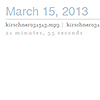 Kirschner’s
highly diverse work has taken a demonstrative turn in the direction of
synthetic chamber music in the last few years, & this release
demonstrates an especially striking example of it. Like so much of
Kirschner’s music it comports itself via slowly-moving materials
(Feldman is an abiding inspiration) that are behaviourally limited &
timbrally shrouded. The effect created is immersive & mysterious,
even magical, but this 22-minute piece sets itself apart from related
works in the way its air of suspension is aggressively broken in its
latter half.
Kirschner’s
highly diverse work has taken a demonstrative turn in the direction of
synthetic chamber music in the last few years, & this release
demonstrates an especially striking example of it. Like so much of
Kirschner’s music it comports itself via slowly-moving materials
(Feldman is an abiding inspiration) that are behaviourally limited &
timbrally shrouded. The effect created is immersive & mysterious,
even magical, but this 22-minute piece sets itself apart from related
works in the way its air of suspension is aggressively broken in its
latter half.[self-release - free download]

1 | Man Without Country – Entropy Pt. 1
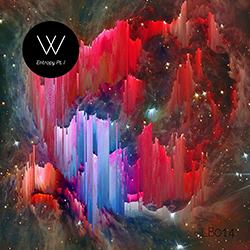 In my recent appraisal of Man Without Country,
i noted how, with this remarkable EP, “the songs have outgrown
themselves & become vast anti-paeans, the scale of their themes
requiring not just musical but physical space. In short, they sound big,
their scale reinforced by unstoppable percussion & a rare, aching
lyricism that enables the songs to attain dizzying heights”. i won’t
just echo those sentiments here, i’ll underline them. 2013 is a year
that’s seen heavily hyped, over-discussed releases from many of the
leading figures in contemporary pop, & even the best have shown
themselves to be wearyingly predictable, lyrically mundane & lacking
real imagination.
In my recent appraisal of Man Without Country,
i noted how, with this remarkable EP, “the songs have outgrown
themselves & become vast anti-paeans, the scale of their themes
requiring not just musical but physical space. In short, they sound big,
their scale reinforced by unstoppable percussion & a rare, aching
lyricism that enables the songs to attain dizzying heights”. i won’t
just echo those sentiments here, i’ll underline them. 2013 is a year
that’s seen heavily hyped, over-discussed releases from many of the
leading figures in contemporary pop, & even the best have shown
themselves to be wearyingly predictable, lyrically mundane & lacking
real imagination.Seen alongside that kind of crestfallen clamour, both the ingenuity & the lyrical clout of Man Without Country’s music stand tall & clear. As i mentioned previously, there’s an element of lyrical retreat (or, at least, reticence) in the four songs that make up Entropy Pt. 1, but the sentiments impelling those songs is as palpable as ever. The duo’s fondness for alternating huge, synth-driven outbursts & subdued, semi-whispers lends them a particular kind of emotive power, but quite apart from that, the exquisite beauty that permeates Man Without Country’s songs distinguishes them as leaps & bounds ahead of the competition. This EP is their most mature release to date, & on the strength of it they are surely one of the hottest prospects for 2014. To quote myself again, “This is about as good as contemporary electronic pop gets”.
[Man Without Country | iTunes]
Nema komentara:
Objavi komentar